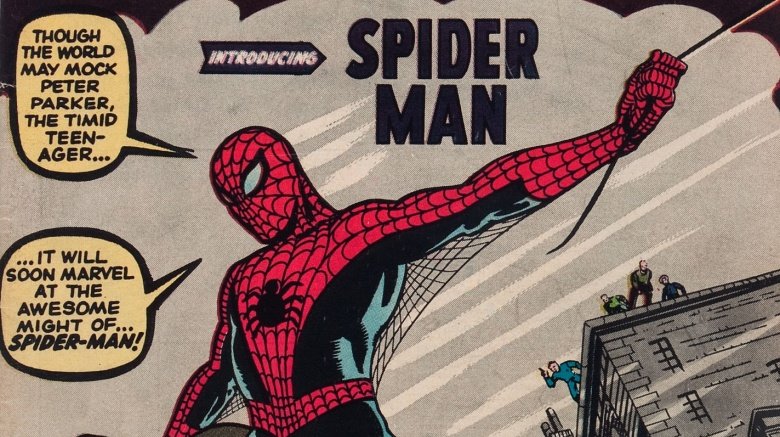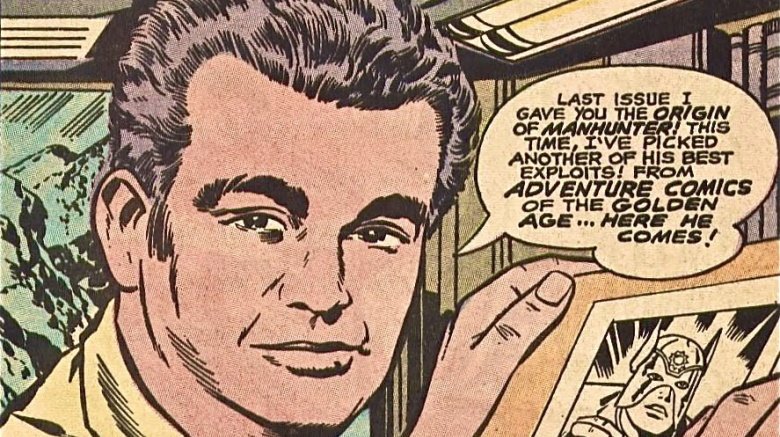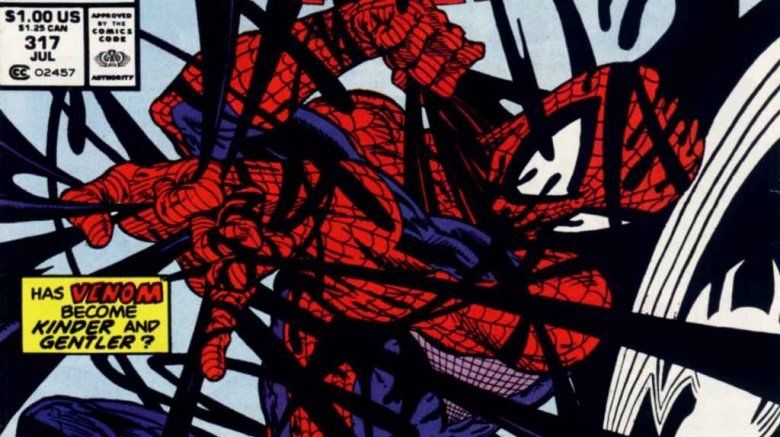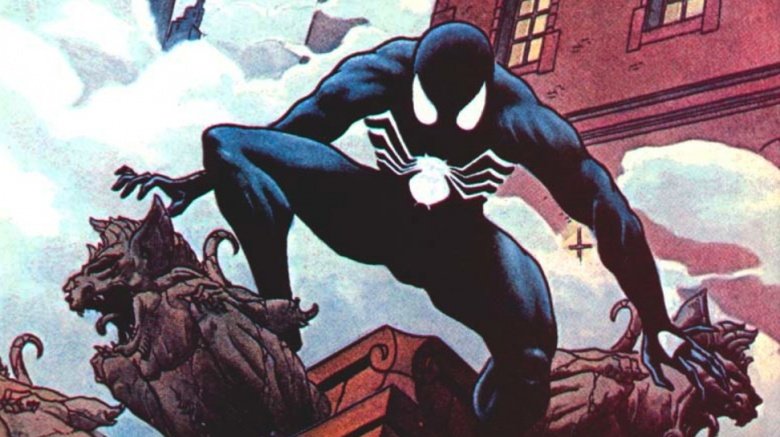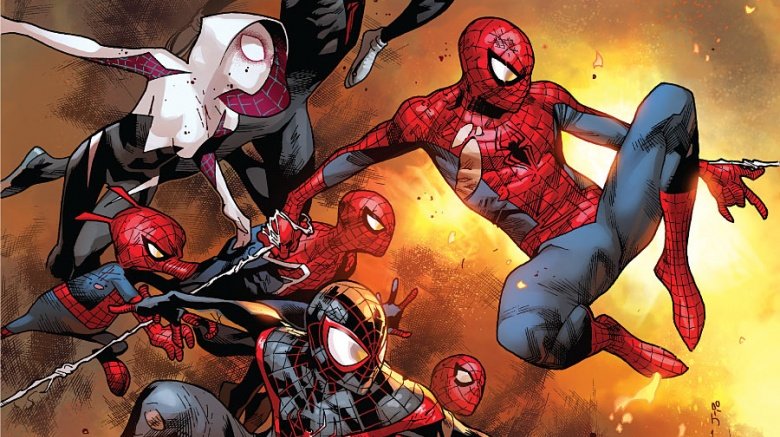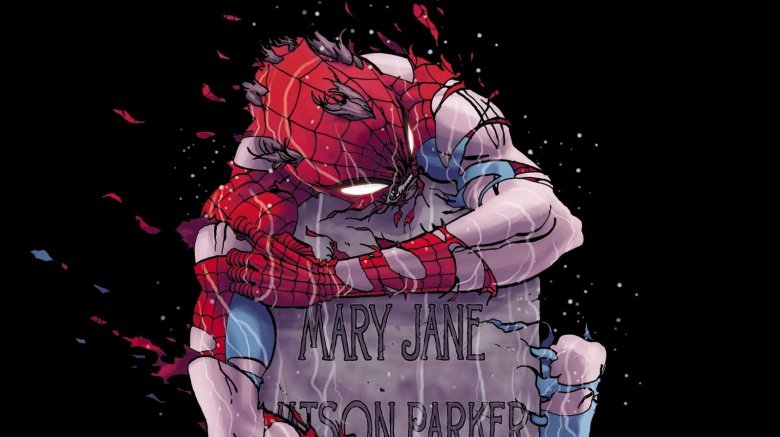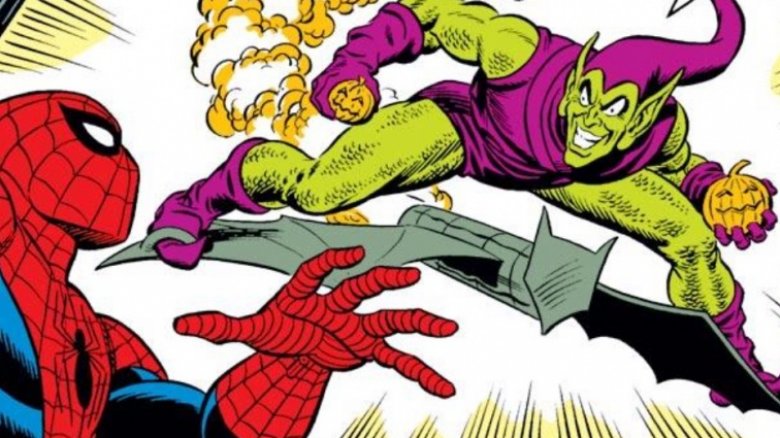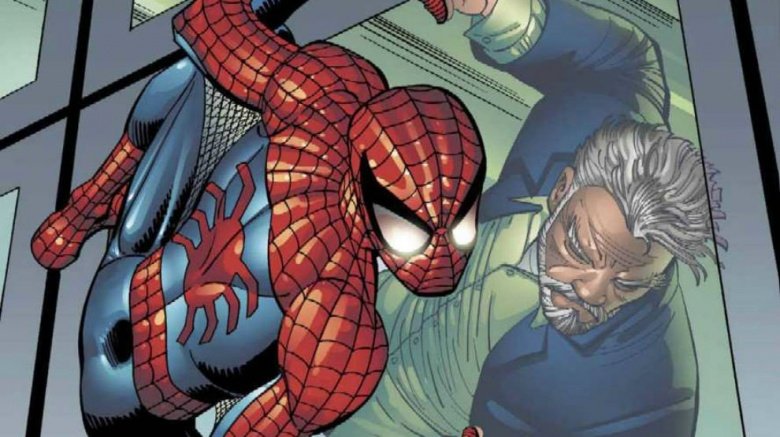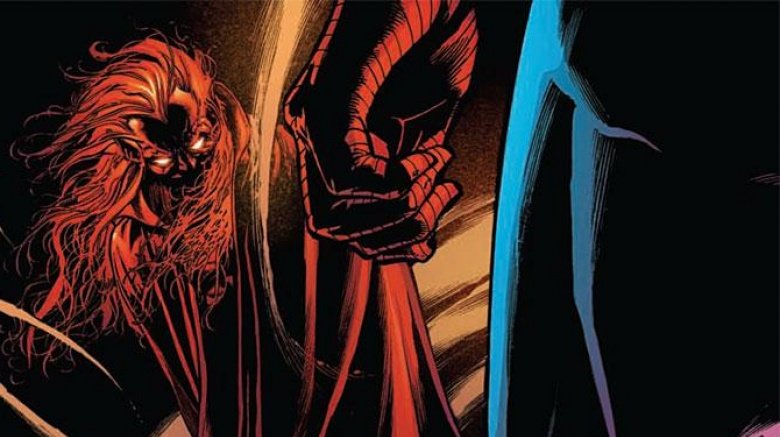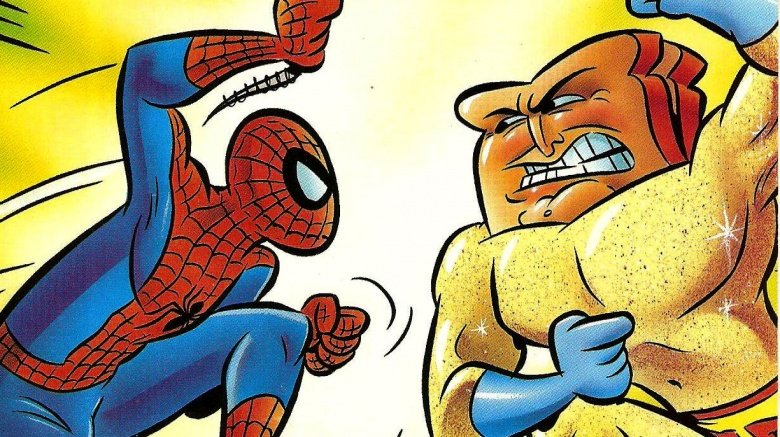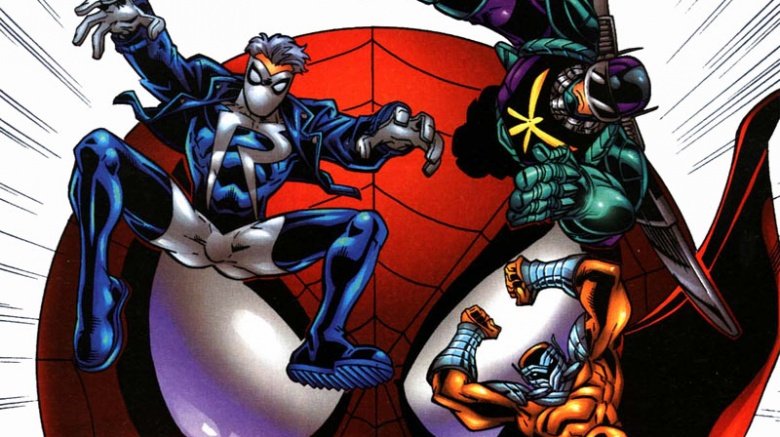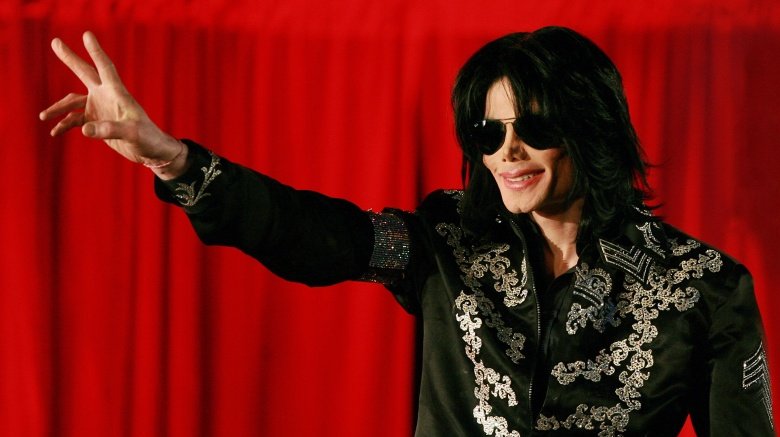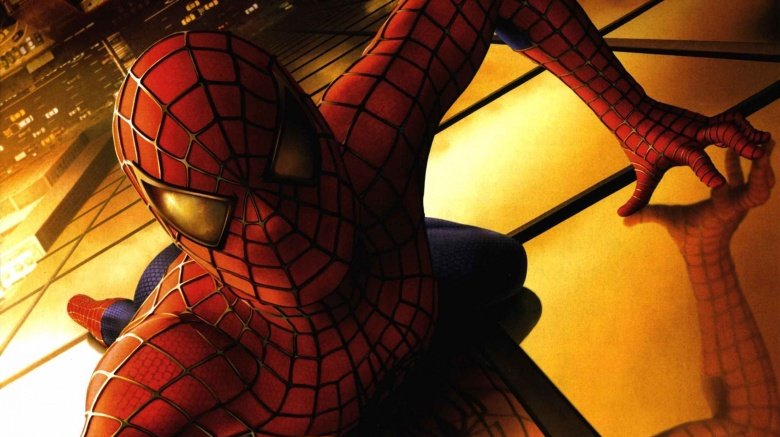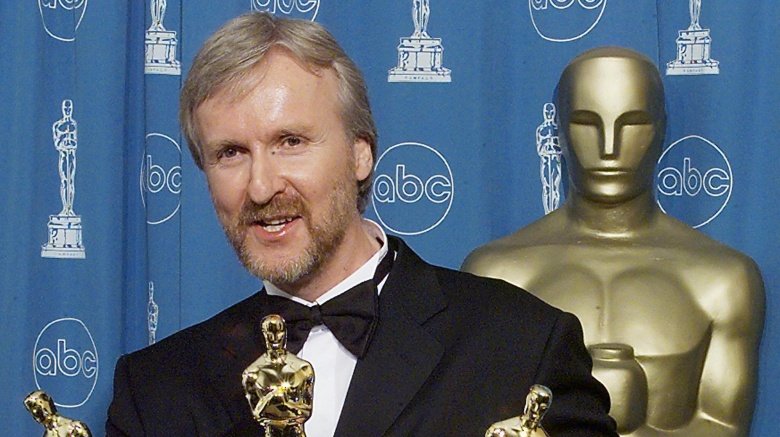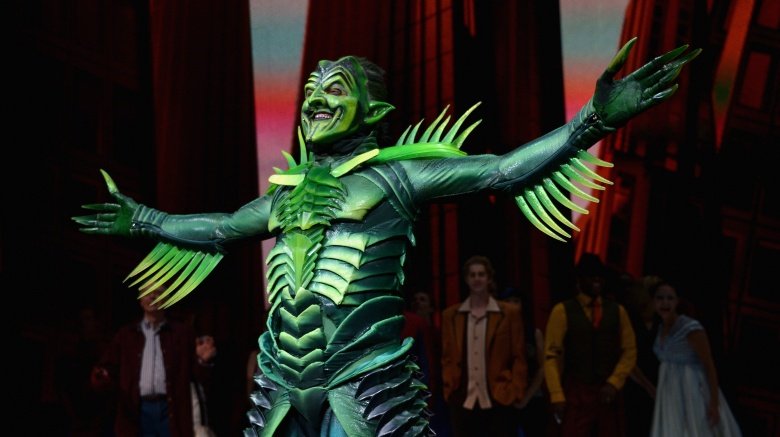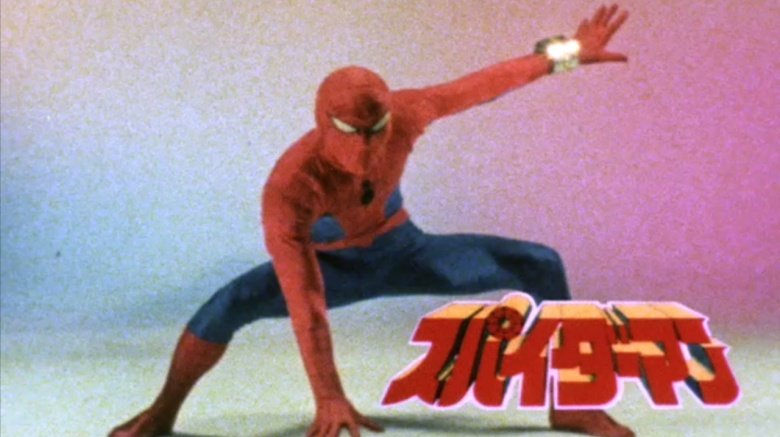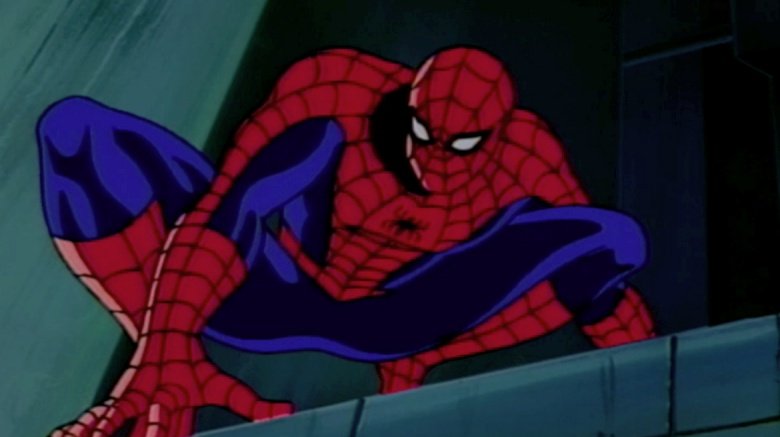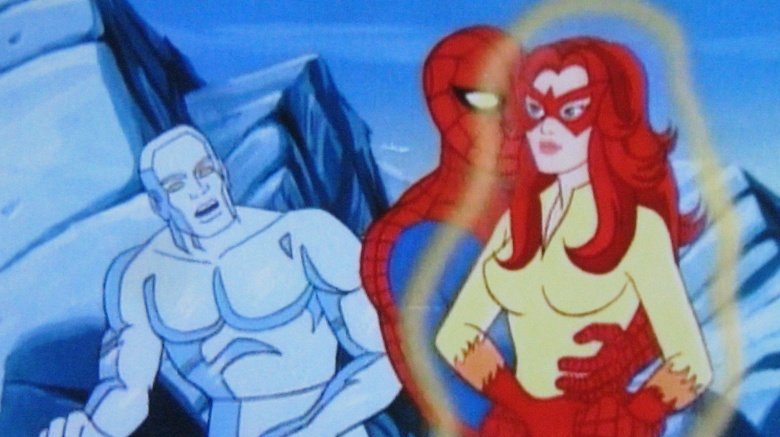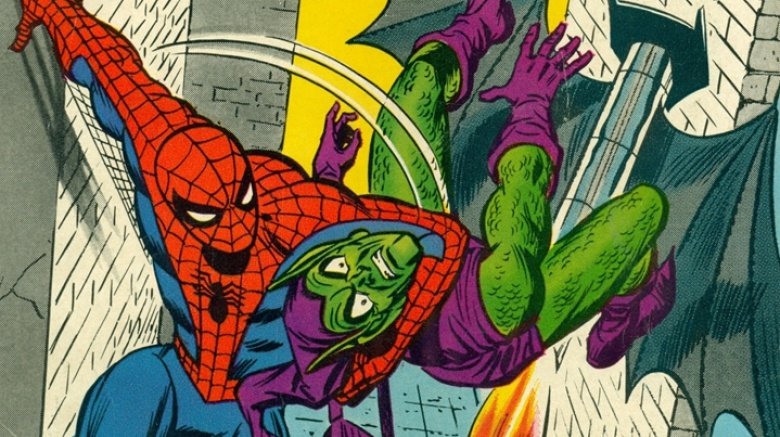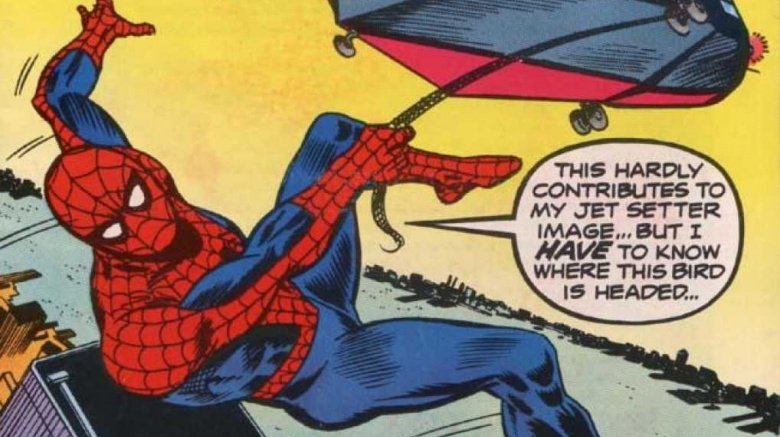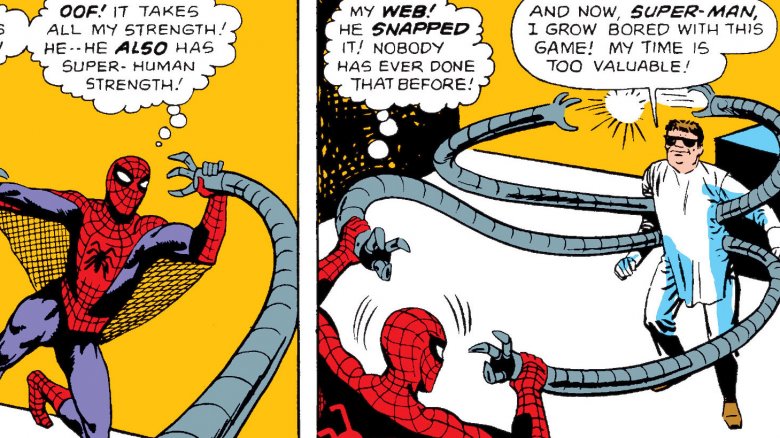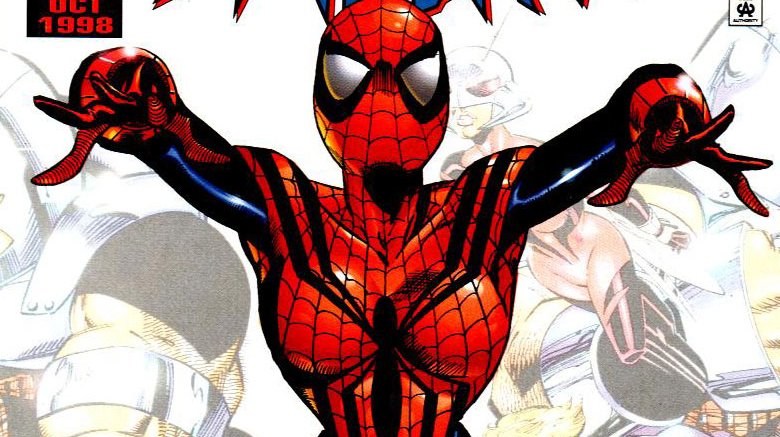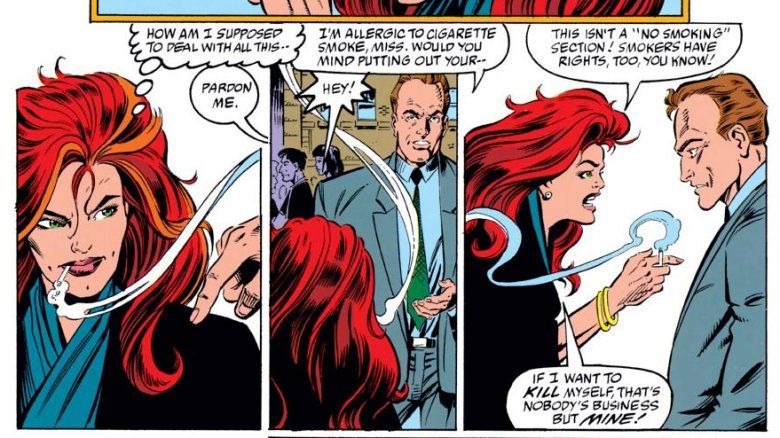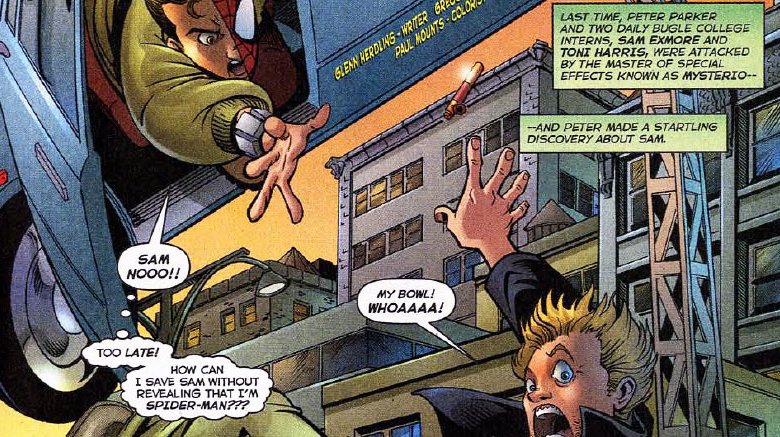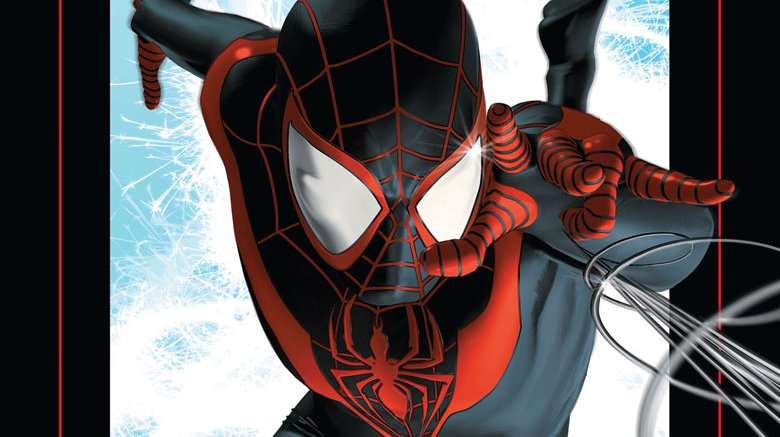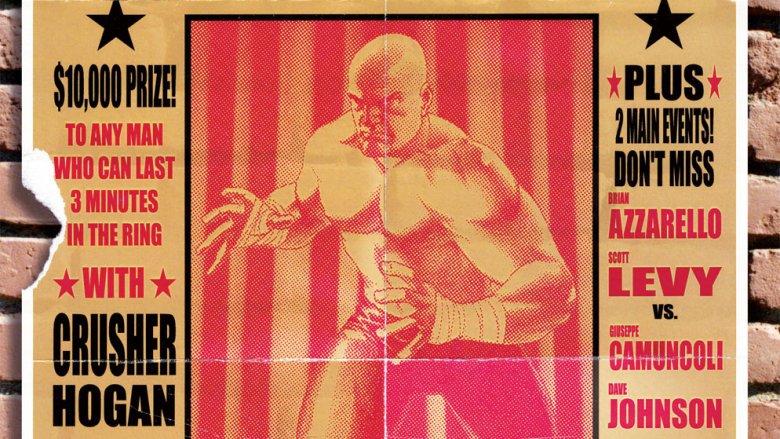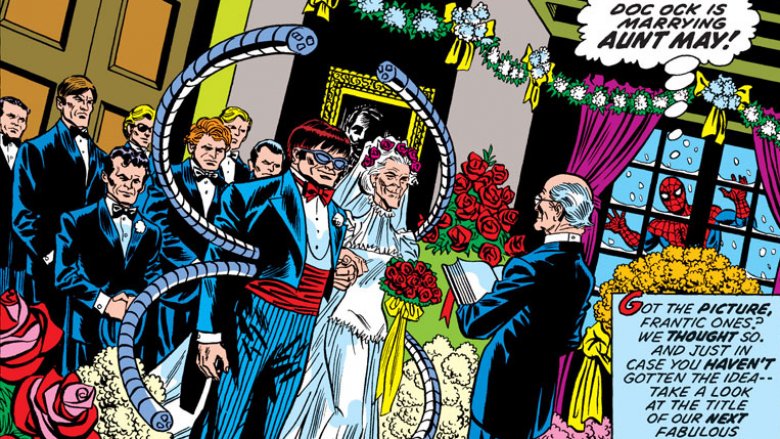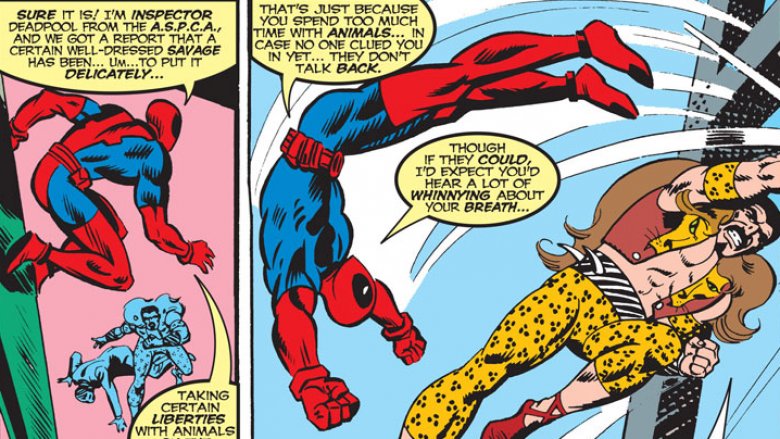The Untold Truth Of Spider-Man
We may receive a commission on purchases made from links.
When teenage nerd Peter Parker is bitten by a radioactive spider during a field trip to a lab, he gains a weird selection of arachnid powers and spends the rest of his days balancing vigilante crimefighting against leading a normal life. Sounds pretty tricky, right? Even under the best of circumstances, it would have to be — except it's never really been even that simple for our friendly neighborhood Spider-Man. Over the course of his many decades as a bestselling cornerstone of the Marvel Comics universe, Spidey's history has taken so many twists and turns that even for longtime readers and the most hardcore of Spider-Man enthusiasts, it's far from easy to keep track of this classic character's tangled web. Whether you're a novice or a self-proclaimed Spidey expert, we've rounded up a whole mess of facts that you probably didn't know about the world's most beloved wall-crawler. Here's the untold truth of Spider-Man.
A true original?
In 1954, legendary Halloween costume manufacturer Ben Cooper Inc. began selling a "Spider Man" outfit. The kid-sized duds were little more than a yellow ensemble covered with drawings of webs, and the words "Spider Man" written across the forehead, giving the overall impression of a poorly-dressed idiot who'd recently escaped from a basement or something.
Years later, a more familiar Spider-Man made his debut in 1962's Amazing Fantasy #15, the final issue of a doomed Marvel Comics anthology series. While Cooper's earlier Spider Man may seem like a huge coincidence, the case is complicated by rumors that Jack Kirby, the original artist for Spider-Man (before Steve Ditko took over) was working for Ben Cooper at the time, as both Cooper and Marvel were located in Manhattan, and Kirby's work was pretty diverse. Newsarama explored the case and got a terse reply from Ditko and silence from Marvel, which definitely sets our spider-senses tingling.
Spider origins redux
Artist Jack Kirby had his hands in the creation of just about every major comic character you've ever heard of. While the first appearance of Spider-Man was written by Stan Lee and drawn by Steve Ditko, Lee originally had Kirby draw the first five pages of Spidey's debut. The pages didn't hit the mark and were scrapped. For the final version, Lee's original plot and Kirby's costume designs were changed, and Kirby ultimately only drew the cover of Amazing Fantasy #15.
Unfortunately, this didn't stop Kirby's heirs from trying to claim remuneration for Marvel's use of Spider-Man in 2009. Even Lee, Kirby's everlasting partner in mighty Marvel creativity, denied the Kirby family's claim. According to Deadline, the suit was settled on undisclosed terms in 2014, which is even more suspicious than Norman Osborn's crazy cornrows.
20 Ingram Street
Over the course of 1989's Amazing Spider-Man #316 and 317, readers were shown two halves of a change-of-address form filled out by Peter Parker, and only curious readers who assembled them saw that the Parkers were now living at 20 Ingram Street in Forest Hills, NY. Whether or not this was an Easter egg planted by writer David Michelinie or artist Todd McFarlane is unknown, but as of 1974, there really was a family named Parker at that address, who soon began receiving mail addressed to the fictional Peter. When the New York Times explored the story in 2002, they also discovered that 19 Ingram Street was home to a family named Osborne—just one letter off from Spider-Man's arch-nemesis, Norman Osborn.
Back in black
When he's not wearing his red-and-blue duds, Spider-Man is known for wearing a stealthy and slimming black, which he found in an alien vending machine during 1984's Secret Wars arc and decided to slap on his body. What readers might not know is that the black costume wasn't an original idea from the House of Marvel, but an idea sent in by a fan for a contest in 1982.
While Randy Schueller's costume idea involved underarm webbing and a red logo, the similarities to the official Black suit remain. Schueller was paid for his idea: $220 dollars, which would be about $550 today. Schueller's other ideas would later be incorporated into additional Spidey costume ideas: unstable molecules and thought control were both used by Spidey's Future Foundation and Iron Spider costumes respectively, but Schueller was never given any actual credit, according to his own post on Comic Book Resources.
Center of the web
Comics fans might not think about it much, but Spider-Man is the absolute center of the Marvel multiverse. Even though heroes like Captain America and Iron Man get top billing, there are more versions of Spider-Man across the multiverse than any other hero, and any time we visit another reality, Spider-Man is so iconic and consistent that he's always there, and generally used as a compass to differentiate the different planes of existence. While the main Marvel continuity, Earth-616, has its own fair share of Spideys, there are literally hundreds of alternates, including Spider-Ham of Earth-8311, the flaming skull-headed Ghost Spider of Earth-11638... and a whole lot of dead Spider-Men, since Peter seems to get caught in the ol' bug zapper of life pretty often.
Radioactive Peter
In one of these alternate realities, set in the distant future, a 70-year old Spider-Man comes out of retirement to fight a totalitarian New York City government. In a battle with the Sinister Six, Doctor Octopus commands his tentacles, which are now posthumously carrying around his corpse, to exhume Spidey's ex-wife Mary Jane from her grave. Peter has a total breakdown and admits that MJ died of cancer due to exposure to Spider-Man's own radioactive body. It's a weird vision of a distant future that will never happen to our beloved, and kinda gross, Spidey.
The cruelest revenge
Spider-Man has probably had the roughest life of any superhero; he doesn't have Batman's wealth, and he doesn't have Superman's strength, but he accomplishes pretty much the same heroic stuff. But the very worst thing that ever happened to Spider-Man was being cheated on by his girlfriend, Gwen Stacy, with his arch-nemesis, Norman Osborn, a.k.a. the Green Goblin. While this was never spoken of during Gwen's life, the 1999 storyline Sins Past revealed the ultimate betrayal: Gwen had kept her terrible goblin babies secret, and because of their unique DNA, they aged rapidly and came after Peter Parker, 'cause that's what goblins do. Everyone, Peter Parker and comic readers included, hated the whole thing.
Spider-Magic
Everyone knows that Spider-Man's powers are purely scientific in nature, because being bitten by a radioactive animal automatically transfers its powers to you. That's just basic biology. Except in 2001, the arrival of a character named Ezekiel revealed that Spidey's superhuman abilities were actually kinda magic, and that fateful radioactive spider bit Peter Parker on purpose, because of cosmic mystical machinations. It's a bit like the midichlorians of the Marvel Universe, but it also kinda explains why most of Spidey's bad guys are animal-themed.
Deal with the Devil
The apex of weird Spider-Man storylines is Peter Parker's deal with the devil, Mephisto. In exchange for the survival of his dear, decrepit, nearly-deceased-anyway Aunt May, Spidey would give up his marriage and future kids with Mary Jane, forcing him straight back into the friend zone. Spidey's reason for taking this deal? Peter's Aunt May was hovering between life and death because she'd been put in danger after he revealed his secret identity during Civil War, and he'd come to the sensible conclusion that taking off his mask in front of the world had been a big mistake. In return for Peter sacrificing his life with Mary Jane, Mephisto made the world forget he was Spider-Man, thus protecting his loved ones from the line of supervillain fire.
Crossover madness
Spidey is a guy who gets around in some pretty weird places. In 1978, Peter and Mary Jane attend a taping of Saturday Night Live, and a mix-up between villain Silver Samurai and John Belushi's samurai character causes an issue-long ruckus featuring the entire 1978 SNL cast. In 1993, Marvel had the rights to publish a comic series based on Ren & Stimpy, so Spider-Man ended up battling Powdered Toast Man in those pages—and getting one-punched through a wall by the bread-headed hero. And in 2009, Spider-Man rescues none other than Barack Obama from Chameleon, who decides to impersonate the president-elect moments before the inauguration. And that's truly only the tip of the weird-berg.
So many spiders
At one point in Marvel's history, Spider-Man was so popular that he starred in four books at once, making it nearly impossible to keep track of his adventures (or even take a nap). All of it came to a head when Norman Osborn framed Spider-Man for murder, forcing Parker to drop his heroic persona and take on a different heroic mantle...or four. As Hornet and Prodigy, Peter continued his heroics, and as Dusk and Ricochet, he was able to infiltrate New York's criminal underworld to find the real murderer. Spidey was able to drop his alternate identities, but they were later taken up by a group called the Slingers, who were quickly beaten by the New Warriors in a game of basketball and pretty much never seen again.
Mary Jane is not my lover
At some point during the 1990s, pop star Michael Jackson made moves to try and purchase Marvel Comics, only because he wanted to play a heroic character when it came time to make some Marvel movies. It was revealed in 2011 that Jackson petitioned X-Men's producers for the role of Professor X, for reasons that are now a complete mystery to all humanity, but Stan Lee's recollection was different. In their personal conversations, Jackson revealed to Lee that he really wanted to play Spider-Man, though Tobey Maguire eventually got the role, probably saving the Marvel movie universe as we know it.
Trailer trashed
Speaking of the original 2002 Spider-Man, the film's original theatrical trailer had to be completely pulled and scrapped after the events of 9/11, due to the fact that the entire thing hinged upon a helicopter being caught on a web between the Twin Towers. Since the terrorist attacks happened after much of filming was completed, but before the film's theatrical release, the Towers were cut from a handful of scenes. The replacement trailer featured Spider-Man perching on an American flag instead.
King of the world
Prior to Sam Raimi's Spider-Man, director James Cameron took a crack at writing a script for the web-head, but because of a ton of legal and contractual problems, the film never moved beyond a basic treatment. Attached names included Leonardo DiCaprio as Spider-Man and Arnold Schwarzenegger as Doctor Octopus, with other appearances by villains Electro and Sandman. With Spider-Man yanked from his grasp, Cameron went on to write Titanic instead, making sure that the world got its much-needed dose of DiCaprio anyhow.
Spandex sadness
Spider-Man's many portrayers have all had very different reactions to the tights. Newest actor Tom Holland's duds were designed for his stunt double, so when he put them on, they were a bit too baggy, bumming out Holland during his first time in the suit, according to Comic Book Movie. Tobey Maguire was pretty uncomfortable until the costume designers put in a bathroom portal, and despite bathroom breaks being a known problem for Spider-actors, the costume department again forgot to include a vital flap for Andrew Garfield, who only had the addition put in during his second outing as the character. Still, according to Geek Tyrant, Garfield was so taken by the fact that he got to play the iconic hero that he cried when he first put on the suit.
Turn off the dark
Spider-Man's films aren't the only times he's been made into a live-action hero. In 2010, director Julie Taymor brought Spidey to Broadway in a play so fraught with problems that it quickly became an unintentional comedy of errors, even with music by the members of U2. By opening day, the production had already cost $65 million, and not even Disney, who had recently purchased Marvel, had any interest in helping out. A disturbing number of actors and extras were injured during production due to the show's complex stunts, and at one point, Green Goblin became stuck on a wire over the audience, hanging there for a few minutes before the show could begin again. Not even the Clone Saga was this embarrassing.
Spider sentai
Broadway wasn't the only place to suffer from a misguided live-action Spider-Man. In 1978, Japanese production company Toei took note of Spidey's tight costume and likened him to their own skin-tight Tokusatsu heroes, like Kamen Rider. Japan's Spider-Man was given an origin not unlike DC's Green Lantern, when he's given a fancy device and powers by an alien from the planet Spider, who he finds in a crashed UFO called "Marveller." In true Japan form, Spidey also gets a transforming robot, which he uses to fight against Professor Monster. The show ran for 41 episodes, all with Marvel's approval, and amazing episode titles like "Becoming Splendid: To the Murderous Machine of Transformation," and "The Onion Silver Mask and the Boys' Detective Group."
Spider-Manimation
In 1992, Marvel and Saban had a huge hit with their X-Men animated series, so Marvel decided to build on this success by debuting Spider-Man in 1994. While Spidey's series was also an action-figure-spawning phenomenon, it was subject to completely absurd censorship. While it's reasonable to request that a kids' cartoon omit animated blood, it made less sense to forbid even the mention of blood—even in an episode where Morbius, the Living Vampire appears, and can no longer be called a vampire. Other rules included no breaking glass, no punching (except in limited circumstances), and no use of the word "sinister." This last one is especially odd, as Spidey's main villain collective is known as the Sinister Six, and Mr. Sinister was over on X-Men villaining it up on the reg. Sorry, kids, basic English vocabulary is too rough for your little pudding brains and bloodless bodies.
Spider-Man and His amazing bans
This wasn't the first time an animated Spidey ran into trouble, however. Spider-Man and His Amazing Friends, a cartoon from 1981, only aired their Nazi-themed "Quest of the Red Skull" episode once before it was never shown in regular rotation again. Much of the episode was a pretty important history lesson for kids, but prominent display of swastikas was a bit too extreme for sensitive 1981 viewers. According to Comic Book Resources, the episode showed up at least two more times on TV, many years later, but was completely dropped from all rotations once Disney took over, leaving history to outdated public school textbooks.
Say No to bugs
Because Spidey is pretty much an everyday, average guy, he's been used countless times as a tool for educational purposes, from direct-to-VHS shorts about child abuse to full comic arcs about the dangers of drugs. When the U.S. Government approached Stan Lee to write an anti-drug story in 1971, he was all for it, according to the CBLDF, as long as it was a good story. Strangely enough, this was during a time when the Comics Code Authority also expressly forbade any mention of drugs whatsoever. After the story was shot down by the CCA, Lee made the difficult decision to run it anyway. It was so well-received that the CCA changed its own code, opening up comics to a much wider range of educational stories.
Oh baby
Spidey's strangest foray into educational materials was definitely "The Pull of the Prodigy," a 1976 story written by Ann Robinson for Planned Parenthood. In an amazingly surreal plot, the alien villain called Prodigy (no relation to Spider-Man's previously mentioned alter-alter-ego) uses the powers of alien persuasion to try to convince teenagers to make babies so that he'll have tons of minions to do his bidding. Part of the Prodigy's propaganda was to straight up say that diseases weren't possible and doin' it didn't really cause pregnancies. Of course, Spidey laments how tough his life is even without a rugrat, and defeats the Prodigy before it's too late. If anyone was poised to lecture kids about celibacy, it was nerdy Peter Parker.
Peter Palmer, the Spectacular Super-Man
Here's a fun piece of trivia: if you've ever wondered why so many of the early Marvel characters had alliterative names, it all comes down to Stan Lee trying to streamline his creative process. He was, after all, the one responsible for scripting about a dozen books a month in the early '60s, he'd often give the main characters snappy names like "Reed Richards," "Bruce Banner," and "Sue Storm" to make them easier to remember. Peter Parker, obviously, was one of those characters, and while it's a solid plan in theory, it didn't always work out so well in practice.
It didn't take long for the flaw in that plan to surface, either. Amazing Spider-Man #1, the very first issue of Spidey's ongoing series, featured a story where Spidey went up against the Chameleon, and was consistently referred to as Peter Palmer by mistake. Stan would later take full credit for that error, citing the newness of the character and his rigorous writing schedule as the culprits, which is pretty understandable.
The mistake he made in Amazing Spider-Man #3, however, is a little more surprising — and a little more copyright-infringing. When he took on Doctor Octopus for the first time, his civilian name is given correctly as Peter Parker, but in one panel, Doc Ock refers to our web-slinging hero as "Super-Man" instead. Fortunately, everyone was a good sport about Stan's goof, and both "Peter Palmer" and "Super-Man" are still there in reprints of those early issues.
Spidey Super Stories
A decade after his debut, Spider-Man's popularity had gotten to the point where it had gone well beyond the comics page. He'd starred in a TV cartoon in 1967 that would eventually supply the internet with an endless source of memes, and in 1975, he'd even be the subject of a weird and completely official concept album called Spider-Man: Rock Reflections of a Super-Hero. In 1974, though, Spidey was introduced to a whole new audience thanks to The Electric Company, an educational TV series for kids that ran on PBS.
In addition to segments like "Easy Reader," in which a young Morgan Freeman expressed a love of simple books, the show featured a recurring segment called "Spidey Super Stories," where Danny Seagren appeared in full costume as Marvel's favorite wall-crawler. Rather than the usual supervillains, the Electric Company's Spider-Man took on goofy criminals who committed "crimes" like ruining birthday parties or swapping out someone's lunchtime sandwich with a rubber glove between two slices of bread. He also never spoke, instead communicating with the viewers (and with other characters) via word balloons and thought bubbles as another tactic for encouraging the young viewers to read.
To tie into the show, though, Marvel also produced a Spidey Super Stories comic book that ran for 57 issues — outlasting the original run of the show that inspired it by four years. Running with Easy Reader's seal of approval, it was a lighthearted take on Marvel stories that worked in the show's goofball villains along with Marvel standards for some truly bizarre stories. The stories would often parody the pop culture of the time, like the one where Dr. Doom built a Death Star that ate planets called "Star Jaws." There's even an appearance by Thanos, who, rather than acquiring the Infinity Stones and killing half the universe, mostly commits petty larceny and escapes in a helicopter with his name on it. If you've ever seen the Thanoscopter, this is where it comes from.
Spider-Girl and MC2
Of all the different variations of Spider-Man that have cropped up over the years, the most successful by far — at least in terms of longevity — is also one that might be a little surprising: Spider-Girl, Peter Parker and Mary Jane Watson's daughter from a not-too-distant future of the Marvel Universe. Not only did she hold down her own solo title for a full 100 issues, plus another 40 of spinoff titles, she was the character that launched an entire imprint that focused on the next generation of Marvel's heroes.
Created by Tom DeFalco and Ron Frenz for an issue of What If in 1998, May "Mayday" Parker inherited her father's powers as a teenager. After finding the costume that her "uncle" Ben Reilly — Peter's clone — wore during his brief tenure as Spider-Man in the '90s, she donned it herself and took over as the "web-stunner" for a new generation. Over the next 20 years, she'd be the focal point of stories that introduced readers to her future's versions of the Avengers and the X-Men. In keeping with the "next generation" idea, those teams featured the Juggernaut's son J2 and Wild Thing, the daughter of Wolverine and Elektra, in addition to older versions of established characters like Jubilee and Ant-Man's daughter, Cassie Lang.
Surprisingly — or not, given how hungry audiences are for big-name adventure stories about teenage girls — a character originally slated for a one-off What If appearance quickly found an extremely dedicated audience. The series was never a huge seller, but every time it was on the verge of ending, readers would respond with such vocal support that it was seemingly saved at the last minute. With that kind of enduring popularity, Spider-Girl became one of the few superheroes who can boast that they've escaped from the real-world "death" of having their comic canceled, which in its own way is a lot more impressive than beating up the Green Goblin again.
Mary Jane: smoker?!
For most Spider-Fans, Amazing Spider-Man #361 is remembered for the first full appearance of Carnage, the spree-killing symbiote super-villain who tore his way through comic books and the Super Nintendo in the '90s. If you were paying attention, though, you may have also noticed the start of a saga that pit Mary Jane Watson against her own deadly foe: cigarettes!
Spider-Man has been featured in plenty of PSA-style comics, but MJ's struggle with smoking was about as thrilling as that episode of Saved By the Bell where Jessie got hooked on caffeine pills. Over the next 24 issues, Mary Jane went from picking up smoking to dealing with the stress of being married to a superhero to having cover blurbs telling fans that they needed to pick up the latest issue if they'd "been worried about Mary Jane's addiction?!"
Don't get us wrong: smoking's definitely bad for you and if Spider-Man's sad sack reaction to Mary Jane slowly "killing herself" with cigarettes helped to balance out all those years of Wolverine making cigars look really cool, it was probably worth it. That said, 25 issues worth of high-octane melodrama is a whole lot of real estate to devote to Spider-Man telling kids that cigarettes are bad.
Fastlane
No discussion of Spider-Man's role in PSA comics would be complete without a look back at the infamous anti-marijuana comic, Fastlane. For a four month stretch in 1999 and 2000, it was unavoidable, running as an eight-page insert in every single Marvel comic.
Commissioned at the request of the White House Office of National Drug Control Policy, Fastlane told the story of Zane Wheelan, an actor whose films glamorized drug use, who somehow managed to make Spidey's old enemy Mysterio mad enough to want him dead. While Spidey battled the bad guy, an intern at the Daily Bugle fell into the sordid world of reefer madness, as depicted by an artist who, by his own admission, had never so much as touched a joint in his life. Needless to say, it's pretty amazing.
And it also might be the most widely distributed Spider-Man comic ever printed. It might've frustrated readers by not only interrupting a story, but doing it in a way that sometimes made it difficult to realize that Spidey and Mysterio didn't just show up in the comic you were actually reading, but it didn't just go into every Marvel book for four months. Thanks to the White House ONDCP, it was also printed in magazines like Boy's Life and National Geographic World, racking up an estimated total circulation of 11,000,000 copies. For comparison, the highest-selling comic of the modern era, 1991's X-Men #1, only managed a total of 8,000,000.
A Spider-Man for every decade
Spider-Man is easily one of the most influential comic book characters of all time. He perfected the Marvel idea of a superhero with flaws and relatable problems, and like Superman and Batman, virtually every superhero created after him would be influenced by his adventures in one way or another. He was so influential, in fact, and so successful, that Marvel would try to recreate that success by going back to the same formula and updating it about once a decade.
Spidey himself, of course, was the version that became Marvel's flagship character in the '60s. In 1976, Nova #1 hit newsstands to tell the story of Rich Rider, a New York City high schooler who got cosmic powers and cosmic responsibilities when he inherited the powers of a Nova Centurion from a dying alien, basically combining Spider-Man with Green Lantern's origin. In 1988, Tom DeFalco and Spider-Man co-creator Steve Ditko introduced Speedball, a high school student who got powers in a science lab accident. In 1991, it was Darkhawk, a high school student who discovered his father was a crooked cop and then found a mysterious amulet that turned him into an armored warrior.
The 21st century is where it gets a little interersting. Rather than creating a new character with a new tweak on the Spider-Man formula, 2000 saw Brian Michael Bendis and Mark Bagley launch Ultimate Spider-Man, a series about a young Peter Parker's first few years as a teenage superhero that would eventually grow to launch its own universe. Then, in 2011, Bendis and Sara Pichelli would tweak the formula yet again by introducing an all-new Ultimate Spider-Man, Miles Morales.
Arachna-Man
It makes sense that a character as popular as Spider-Man would have his share of knockoffs, but one imitator wasn't confined to the comics page. Instead, he made his debut in the world of professional wrestling.
Brad Armstrong's career in wrestling was both long-lived and successful, but in 1991, World Championship Wrestling was in search of a gimmick for him. He was a member of a pretty prodigious wrestling family — his father was "Bullet" Bob Armstrong and his three brothers would go into the business as well, with Brian going on to pretty great success later that decade as "The Road Dogg" Jesse James — but his tenure in WCW had been marked by a string of failed gimmicks. He'd previously been seen as "The Candyman," who wore candy-cane striped tights and handed out sweets to the crowd, and Fantasia, a masked member of the Fabulous Freebirds. After those, though, he hit what is commonly regarded as a low point in his career when he adopted the identity of Arachna-Man.
Arachna-Man was, as the name implies, just a straight up ripoff of Spider-Man with a more eye-searing color scheme, who came to the ring spraying silly string "webs" at the audience and his opponents. It probably goes without saying that the gimmick didn't last, but there's one weird wrinkle to the story. While it's commonly accepted that threats of legal action from Marvel caused WCW to drop the Arachna-Man character, the two companies actually had a working relationship at the time. From 1991 to 1992, Marvel published an officially licensed WCW comic book, although sadly, the real Spider-Man never made an appearance.
Whatever happened to Crusher Hogan?
He might not have the name recognition of the Green Goblin or Doc Ock, but before Spider-Man could face off against them, he had to take on his very first opponent: Crusher Hogan. Appearing for only two pages back in Amazing Fantasy #15, Hogan was a pro wrestler who offered a cash prize to anyone who could last three minutes in the ring against him, and made a perfect foil for Peter Parker to test out his brand new powers. If you've been wondering what happened to him after, though, well... it's not great for him.
In Amazing Spider-Man #271, a story called, fittingly enough, "Whatever Happened to Crusher Hogan?" recast him as a broken down janitor at a boxing gym who told all the rookies that he'd helped train Spider-Man. Unfortunately, he was on the wrong side of Manslaughter Marsdale, a massive, super-strong gangster who was extorting him. When Spider-Man showed up to deal with the supervillain, he also pulled off the babyface move of telling all the other boxers that Hogan actually was the guy who helped him get his start.
A much darker take, however, came in "The Last Shoot," from Spider-Man's Tangled Web #14. Co-written by Brian Azzarello and pro wrestler Scott Levy — better known to wrestling fans by his in-ring name, Raven — this story showed Crusher as the struggling star of an independent wrestling company on the verge of bankruptcy. In a last-ditch effort to make money, Crusher, a "shooter" (a wrestler actually skilled in non-scripted shoot fights), riled up the fans and offered a cash prize to anyone who could beat him. The gimmick worked, and just when things started to look like they were turning around, a masked Peter Parker showed up to try his luck and walk away with the prize. To make matters even worse? It was revealed that Crusher borrowed the money from Hammerhead, a mobster who told him that he'd crush his hand in the trunk of a car if he wasn't able to pay it back. Great responsibility indeed.
The Many Loves of Aunt May
Spider-Man's been dealing with his grief over Uncle Ben's death for quite some time now, but let's be real: it's been 50 years, and for Aunt May, that's more than enough time to move on.
It might be surprising, but it turns out that May Parker is pretty active on the senior citizen dating scene, although she doesn't have the best luck. She once dated Spider-Man's arch-enemy Otto Octavius (better known as Doctor Octopus), and even made it all the way to the altar in Amazing Spider-Man #131. Sadly, Doc Ock was only after a Canadian uranium mine that May had inherited, which wound up exploding when Hammerhead tried to get his hands on it too. After that, she fell in love with Nathan Lubensky, an unassuming senior who turned out to be a gambling addict who was stealing money from her bank account. He would eventually die at the hands of the Vulture.
More recently, she once again found love in an unlikely place: John Jonah "Jay" Jameson Sr., the father of Spider-Man's longtime boss and most vocal critic. This relationship proved to be a much better match than the others, and even resulted in Jay and May getting married. Tragically, their marriage was cut short when Jay died of a rare, hereditary disease, leaving May widowed for a second time.
The Amazing... Deadpool?
One of the weirdest moments in Spider-Man's history didn't happen in an issue of Spider-Man at all — at least not technically. Instead, it happened in the pages of 1998's Deadpool #11. In this extra-sized issue, Joe Kelly and Pete Woods sent Deadpool back to a moment in Marvel's distant past — namely 1967's Amazing Spider-Man #47.
After landing in the Parkers' Forest Hills home, Deadpool had to preserve the timeline by disguising himself as Peter Parker, with Blind Al standing in for Aunt May. Since they were actually back in an older issue, that meant that Deadpool was the one who went dancing with Mary Jane and Gwen Stacy, and who stepped up to fight Kraven the Hunter with some very un-Spidey-like gunplay.
Now here's the really cool part: Woods and inkers Al Milgrom and Joe Sinnott didn't just give the flashback sections of the story a retro look. In addition to drawing new pages in an older style, they also added Deadpool into John Romita Sr.'s pages from the original issue, in some cases just drawing him on top of existing art of Spider-Man for the fight scenes. The resulting comic not only saved Marvel's timeline from collapsing on itself, it provided readers with one of the most fun Deadpool comics of all time — and a weird moment of realizing that once it was published, Spider-Man never actually fought Kraven in that original story.
